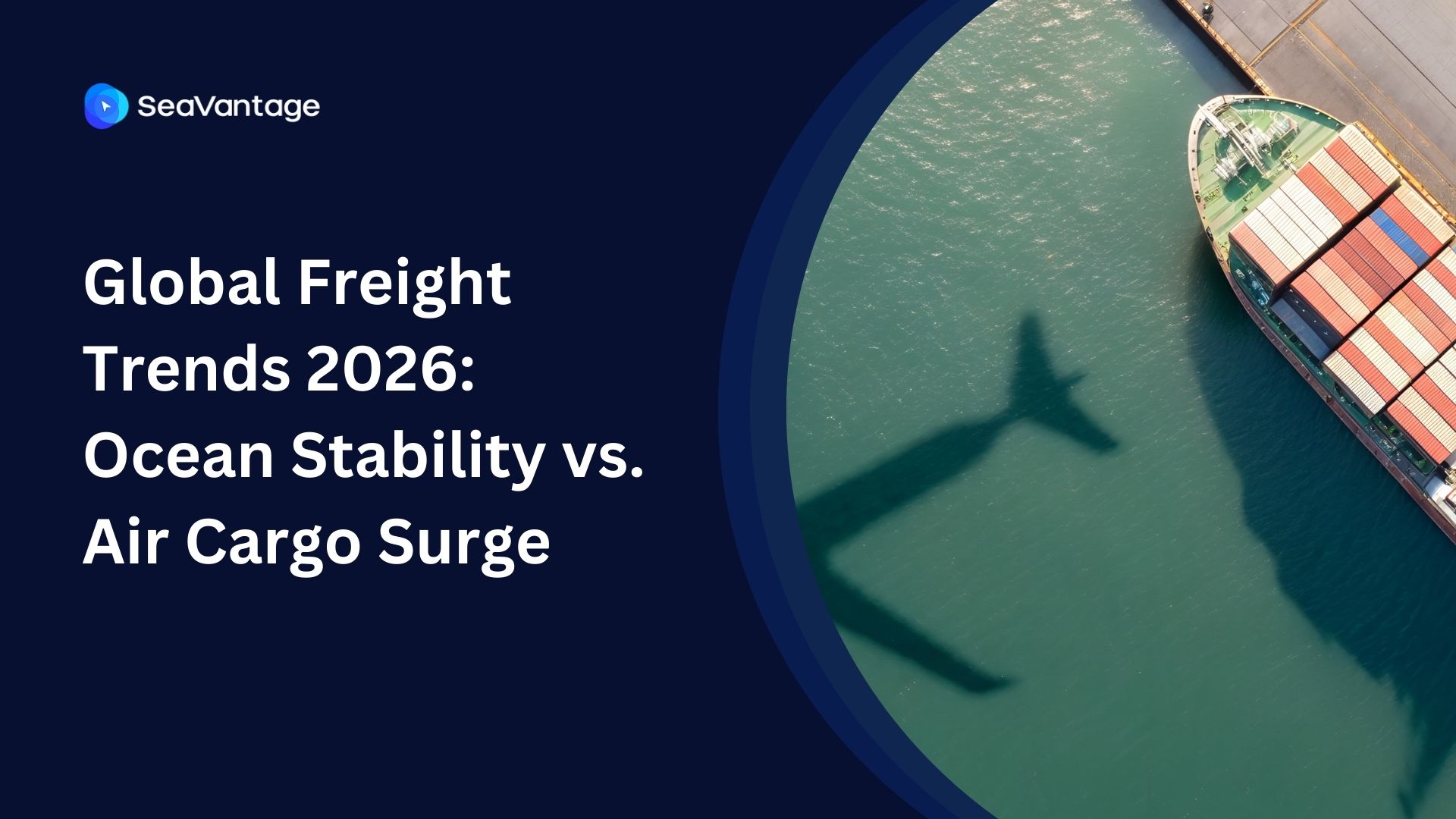Understanding Demurrage vs. Detention: Differences and the Role of Shipment Visibility
Introduction
The new Federal Maritime Commission's (FMS) Demurrage and Detention rules went into effect last month, raising questions among logistics leaders. In response, we explained how these latest regulations differ from the previous ones in a different blog post. In this article, we will explain demurrage and detention costs, highlighting their differences, how they are calculated, and strategies to manage these charges effectively.
Demurrage and detention are often used interchangeably in logistics; however, these terms refer to distinct concepts, even though they are closely linked. While both can involve charges, there are strategies to significantly reduce or avoid these costs in your supply chain.
What are Demmurage Charges?
Demurrage charges are fees imposed on shippers or consignees by a shipping line or port when cargo is not moved out of the terminal or port within a specified period, known as “free time”. Free time is the duration during which the cargo can stay at the terminal without incurring extra charges. Once this period expires, demurrage charges are applied for each additional day the cargo remains at the port.
In simpler terms, it’s a penalty for not clearing cargo from the port facilities within the allowed free time. It's like a late fee for the container. This discourages clogging up the port with unloaded containers and keeps things moving smoothly.
Why do Demurrage Charges Exist?
Efficient use of resources: Ports and container terminals have limited space. Demurrage charges act as an incentive for importers to clear their cargo promptly, preventing congestion and keeping the port functioning smoothly. Imagine a parking lot - demurrage discourages people from leaving their cars in prime spots for extended periods.
Supply chain discipline: Demurrage charges encourage all parties involved (shippers, customs, etc.) to stick to the agreed-upon free time for unloading containers. These charges hold everyone accountable and promote a smooth flow of goods through the supply chain.
Compensation for the carrier: When a container sits idle at the port due to delays, the shipping company loses potential revenue. Demurrage charges act as a form of compensation for this lost opportunity. The carrier can't use that container for other shipments, so they're essentially being charged for the "rental" of their equipment.
Operational efficiency: The shipping and logistics industry relies heavily on schedules. Delays in one area can have a domino effect, disrupting other operations. Demurrage charges incentivize everyone to keep things moving according to the planned timeframe. It's like a train schedule - delays in one train car can cause delays for the entire line.
How Are Demurrage Fees Calculated?
Demurrage fees are calculated fairly simply, but the specific numbers can vary depending on the situation. Here's a breakdown of the key factors:
- Free Time: This is the number of days you get to unload the container at the port without incurring demurrage charges. It's essentially a grace period offered by the shipping line or port terminal. Free time can vary depending on the port, type of cargo, and specific agreements in your shipping contract.
- Demurrage Rate: This is the daily fee you'll be charged for each day the container sits at the port beyond the free time allowance. Demurrage rates are usually set by the shipping line and can vary based on the container size (e.g., 20-foot vs. 40-foot container) and even the specific port location.
- Excess Days: This is the number of days the container exceeds the allocated free time. It's calculated by subtracting the free time from the total number of days the container has been at the port.
Here's the formula for calculating demurrage charges:
Demurrage Charge = Excess Days × Daily Demurrage Rate
For example, let's say:
- Free time allowed: 5 days
- Container sits in port for: 8 days
- Daily demurrage rate: $100 per container
Excess Days: 8 days - 5 days = 3 days Demurrage Charge: 3 days × $100/day = $300
There are a few additional things to keep in mind:
- Demurrage charges typically apply on a per-day basis, even for partial days. So, if the container goes over by even a few hours on a particular day, you'll likely be charged for the entire day.
- Some contracts may have a maximum demurrage charge, acting as a cap on how much you can be charged per container.
- Sliding Scale Rates. Some agreements have rates that increase the longer the cargo remains at the port.
- Seasonal Variations. Rates might change based on the season or peak shipping times.
- Extensions or Waivers. In certain circumstances, shippers may negotiate extensions or waivers to avoid charges.
Strategies to Minimize or Avoid Demurrage Charges in Shipping
Plan for Efficiency
- Accurately forecast the time required for loading/unloading. Precisely forecast these times based on cargo volume, manpower availability, and equipment needed.
- Maintain open communication with everyone involved (customs brokers, truckers, warehouse staff) to ensure a smooth handover when the container arrives.
- Have all import/export documents in order to prevent delays at customs clearance, a major contributor to demurrage charges.
Negotiate and Manage Time
- Having a good relationship with the shipping line might enable you to negotiate for an extended free time allowance, especially for large shipments.
- Book trucks and warehouse space well in advance, particularly during peak seasons or at congested ports, to avoid delays in picking up or storing the container.
Leverage Real-Time Visibility Insights and Proactive Measures:
- Utilize real-time container tracking tools to monitor the shipment's progress and anticipate potential delays. This allows you to react proactively and adjust your plans if necessary.
- Develop contingency plans to address unexpected issues that might cause delays, such as bad weather or unforeseen customs hold-ups.
- Consider using supply chain analytics tools to predict potential delays based on historical data and industry trends
Avoiding Demurrage Charges With Real-Time Visibility Insights
Imagine you're importing a container of bicycles from China. Real-time tracking shows the ship is encountering unexpected delays due to bad weather at sea or congestion at the next calling port. Here's how visibility helps you avoid demurrage charges:
- Early Warning: The tracking system alerts you several days before the estimated arrival at the port.
- Proactive Response: With this lead time, you can:some text
- Contact the shipping line: Discuss the situation and inquire about any potential adjustments to free time allowance due to the delay.
- Alert your team: Inform your warehouse and trucking company about the revised arrival schedule to ensure they can adjust their schedules accordingly.
- Explore off-port storage: If your warehouse isn't ready, research temporary storage facilities near the port to avoid demurrage once the container arrives.
By being proactive with the information from real-time tracking, you can take steps to minimize delays on your end and potentially avoid demurrage charges altogether.
What are Detention Charges?
Detention charges refer to fees that a shipping company imposes on the consignee or importer for holding onto containers or equipment beyond the allotted free time. This free time is the period allowed by the shipping company for the consignee to pick up, unload, and return the empty containers. If the containers are not returned within this period, detention charges are incurred. It's essentially a storage fee for holding onto the container beyond a designated "free time" period.
Why do Detention Charges Exist?
Encouraging Timely Return of Equipment. Shipping containers and other transportation equipment are valuable assets for carriers. By imposing detention charges, carriers incentivize shippers and consignees to return containers promptly. This ensures that the equipment is available for other shipments, maintaining a smooth flow of goods.
Cost Recovery for Carriers. Holding onto a container longer than agreed upon means the carrier incurs additional costs, such as depreciation and potential lost revenue from the container not being available for other customers. Detention charges help carriers recover these costs, ensuring that their operations remain financially sustainable.
Improving Supply Chain Efficiency. When consignees return containers on time, it leads to better equipment utilization and overall efficiency in the supply chain. This helps in maintaining schedules and reducing delays in shipping operations, benefiting all parties involved.
Managing Inventory and Space. Containers not returned in a timely manner can lead to congestion at warehouses and storage facilities. Detention charges encourage consignees to quickly unload and return containers, freeing up space and reducing logistical bottlenecks.
Promoting Accountability. Detention charges place a financial responsibility on consignees to manage their unloading and return processes efficiently. This promotes better planning and accountability in cargo handling operations.
Preventing Abuse of Free Time. By setting clear limits on free time and imposing charges for exceeding it, carriers ensure that their resources are used fairly and responsibly. This prevents any party from monopolizing equipment to the detriment of others.
How Are Detention Fees are Calculated?
Detention fees in maritime shipping are calculated based on a few key factors:
- Free Time Allowance: Every shipping line or contract will specify a "free time" period for returning the empty container after it's been unloaded. This free time allows the consignee (receiver) reasonable time to unpack the goods and prepare the container for return.
- Daily Rate: The shipping company will have a set daily rate for detention charges. This rate typically varies depending on the container type (e.g., 20-foot vs. 40-foot container) and can also fluctuate based on market conditions or specific routes.
- Exceeding Free Time: Detention charges only come into play if the container is not returned within the allocated free time period. The number of days the container is overdue is multiplied by the daily detention rate.
Here's the formula for calculating detention fees:
Detention Fee = (Number of Days Overdue) x (Daily Detention Rate)
For example, let's say:
- Free time allowed = 5 days
- Container returned 3 days late
- Daily detention rate = $75 per container
The detention fee would be:
Detention Fee = (3 days) x ($75/day) = $225
Important Points:
- Detention charges can accrue quickly, so it's crucial to be aware of the free time allowance and plan accordingly.
- Some contracts might have tiered detention rates, where the daily fee increases for extended delays.
- It's always recommended to communicate any potential delays in returning the container to the shipping company as soon as possible. They might be able to offer some flexibility or suggest alternative solutions to minimize detention charges.
By understanding how detention fees are calculated, consignees can manage their container returns efficiently and avoid unnecessary financial penalties.
Strategies to Minimize or Avoid Detention Charges in Shipping
Planning and Communication:
- Be Aware of Free Time: Thoroughly examine the free time allowance outlined in your shipping contract. This is the number of days you have to unload the cargo and return the empty container without incurring detention charges.
- Plan for Unloading: Factor in realistic unloading times when scheduling your shipment arrival. Consider factors like the size and complexity of your cargo, available labor, and any potential delays due to customs clearance.
- Communicate Early: If you anticipate exceeding the free time due to unforeseen circumstances, communicate this to the shipping company as soon as possible. They might be able to offer an extension or suggest alternative solutions.
Optimizing Container Handling:
- Utilize Available Resources: Explore options like hiring additional labor or using specialized equipment to expedite the unloading process and minimize container downtime.
- Coordinate Efficient Return: Plan the logistics of returning the empty container beforehand. This includes identifying the designated drop-off location and ensuring the container is in good condition for return.
- Consider Off-Port Storage: If you anticipate delays in unloading, explore the possibility of using off-port storage facilities to temporarily hold the container. This can help avoid detention charges while you manage the unloading process.
Negotiation and Alternatives:
- Negotiate Free Time: For high-volume shippers, negotiating a slightly extended free time allowance with the shipping company might be possible.
- Explore Alternative Incoterms: Depending on your incoterms (international commerce terms), some might shift responsibility for demurrage charges (which apply within the port) to the seller. However, this doesn't necessarily eliminate the risk of detention charges entirely.
- Consider Shipper-Owned Containers (SOCs): If you frequently deal with containerized cargo, investing in your own containers (SOCs) can give you more control over the return timeline and potentially eliminate detention charges as they apply to empty containers you own. However, managing and maintaining SOCs comes with its own set of responsibilities and might not be suitable for all businesses.
Technology and Visibility:
- Utilize Tracking Tools: Leverage real-time container tracking tools to monitor the location and estimated arrival time of your shipment. This allows for better planning and coordination of the unloading process.
- Invest in Visibility Solutions: Consider investing in digital platforms that provide real-time data on container movement, customs clearance status, and potential delays. This improved visibility can help you proactively address any issues that might lead to detention charges.
By implementing these strategies, you can streamline your container handling process, minimize delays, and ultimately avoid incurring detention charges in maritime shipping. Remember, clear communication, efficient planning, and proactive management are key to keeping your containers moving smoothly and avoiding unnecessary financial penalties.
Avoiding Detention Charges With Real-Time Visibility Insights
Imagine you run a furniture import business and regularly receive container shipments. You typically have 5 days of free time to unload and return empty containers as per your contract with the shipping line. However, unloading a full container of intricate furniture can be time-consuming.
The Problem: During a recent shipment, you receive notification through a real-time container tracking tool that your furniture shipment is arriving at the port a day earlier than expected. This unexpected arrival could lead to exceeding the free time for returning the empty container, resulting in potential detention charges.
The Technology Solution:
- Improved Visibility: The real-time tracking tool not only alerts you to the earlier arrival but also provides access to historical data on your past unloading times. This data helps you more accurately forecast the unloading time for the current shipment.
- Proactive Communication: Based on the data and potential for exceeding free time, you can proactively contact the shipping company through a communication platform integrated with the tracking tool.
The Outcome:
By leveraging technology and better visibility, you can:
- Negotiate an Extension: Knowing your past performance and providing a realistic revised unloading timeline, you can negotiate a short extension on the free time with the shipping company. This can be done efficiently through the communication platform.
- Prepare for Faster Unloading: The earlier notification allows you to adjust your schedule, potentially bring in additional labor, or arrange for specialized equipment to expedite the unloading process and stay within the original free time window.
Benefits of Using Technology and Visibility:
- Reduced Detention Risk: By proactively addressing potential delays, you can significantly reduce the risk of incurring detention charges.
- Improved Efficiency: Real-time tracking and data analytics allow for better planning and resource allocation, leading to faster container turnaround times.
- Enhanced Communication: Technology platforms facilitate smoother communication with shipping companies, enabling efficient negotiation and collaboration.
In conclusion, technology and visibility tools empower you to proactively manage your containerized cargo. By leveraging these tools, you can minimize delays, optimize container handling, and ultimately avoid costly detention charges, ensuring a smoother and more cost-effective shipping experience.
2025년 9월, 주요 글로벌 항만에서 어떤 운송사가 가장 긴 선박 체류 시간을 기록했는지 확인해보세요. 트렌드를 비교하고, 지연을 파악하며, 전체 항만 데이터를 통해 운송 전략을 최적화할 수 있습니다.
2025년 8월, 주요 글로벌 항만에서 어떤 운송사가 가장 긴 선박 체류 시간을 기록했는지 확인해보세요. 트렌드를 비교하고, 지연을 파악하며, 전체 항만 데이터를 통해 운송 전략을 최적화할 수 있습니다.
2025년 7월, 주요 글로벌 항만에서 어떤 운송사가 가장 긴 선박 체류 시간을 기록했는지 확인해보세요. 트렌드를 비교하고, 지연을 파악하며, 전체 항만 데이터를 통해 운송 전략을 최적화할 수 있습니다.
iscover the 4 critical ocean freight trends for 2026, from the Red Sea reopening and fleet overcapacity to shifting global trade maps. Prepare your supply chain now.
Discover key 2026 freight market trends: Port of Houston expansion, air cargo "super peak," and ocean freight stability. Plan your supply chain with SeaVantage.
Explore November 2025 global port dwell time data. See which ports and carriers led in efficiency across Antwerp, Busan, Long Beach, Rotterdam, and Singapore.



.svg)





.jpg)

.png)